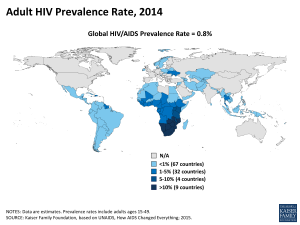
Sobre Nicaragua // About Nicaragua: HIV/AIDS
Introduction
For my focus on Nicaragua, I chose to research HIV and AIDS. I have read a lot about the diseases in other classes, but my focus has been from a social standpoint rather than a medical or community health based one. I have read significantly about ACT UP and social stigmas of HIV in certain African cultures, but it occurred to me that I knew very little about pathology and treatment of the disease. This project has allowed me to gain a much broader understanding of the disease, especially regarding the prevalence in Nicaragua. I found this project was very worthwhile, given that my final project focussed on Zika. As the two viral infections spread by similar means, I felt that there were many intersections between the two projects and means of prevention.
Pathology
HIV, or Human Immunodeficiency Virus is a retroviral infection that may eventually develop into Acquired Immune Deficiency Syndrome, or AIDS. Initial infection is often marked only by typical symptoms of a virus 2-4 weeks after exposure, such as fever, swollen lymph nodes, sore throat, rash, headache and soreness. Because these original symptoms, which often only last a week or two, are often followed by a stretch of no symptoms and some patients have no symptoms whatsoever, many do not know that they are infected. It is often advised that those presenting with any viral symptoms in areas where HIV is common are tested for the virus. As the viral infection progresses, the victim’s immune system is compromised, resulting in susceptibility to common infections such as tuberculosis and opportunistic infections. This latter stage of infection, where the immune system has been fully compromised, is known as AIDS. Without treatment, victims often live only 11 years after infection.
Transmission
The most common form of transmission of HIV is unprotected anal, oral, or vaginal sex. However, the virus can also be spread by blood borne routes such as blood transfusions or hypodermic needles. Other substantial methods of transmission include mother to child transmission during pregnancy, birth, or later breastfeeding. Although many bodily fluids, such as blood and semen, can spread the virus, other such as tears and saliva do not. There are many myths in various cultures about HIV transmission, including that it can be spread by non sexual contact. Such myths have made it difficult to prevent transmission in certain areas, as misinformation has resulted in heightened prevalence.
Prevalence
The most cases of HIV/AIDS currently is in sub-Saharan Africa, although the disease is prevalent worldwide. 36.7 million people were living with HIV in 2015 and 1.1 million people died. These statistics result in HIV/AIDS being labeled as pandemic, meaning that the disease is prevalent in a substantial area and is continuing to spread. In 2015, 17 million people were recieving ARV treatment globally. HIV/AIDS is also associated with substantial economic impacts, meaning that as such a widespread disease it can be a critical burden for already strained economies. It is estimated that only 54% of infected individuals are aware of their status.
HIV/AIDS in Nicaragua
Although HIV likely originated in west-central Africa, it has now spread to various other parts of the world, including Nicaragua. However, although Nicaragua is the second poorest country in Latin America, it has one of the lowest incidences of HIV infection in the area. The WHO estimates that 0.2% of adults are infected in the country, correlating with about 7,700 cases. This low rate of transmission is attributed partially to the ten-year civil war paired with an economic blockade by the United States. These two factors isolated the country, resulting in less exposure from international sources. In addition, the sex industry in Nicaragua is relatively controlled and there is a ban on commercial sale of blood. Therefore, there is no economic gain to be had from giving blood, which has been responsible for transmission in several other countries. However, HIV transmission in Nicaragua is on the rise, with a projected increase of 11.2% in cases each year.
One substantial barrier to prevention is the lack of condom use. Gender norms and religious beliefs take part in decreasing female access to contraception and information about safe sex. Research indicates that only 4-12% of couples use condoms, meaning very low protection from transmission. Another significant cause in the rise of transmission is caused by migrant workers, who work in other neighboring countries for part of the year. These populations are more likely to come into contact with sex workers and are less likely to seek treatment following infection. Adding to the problem is an increase in Nicaragua’s sex industry since the end of the civil war.
In 2008, about 1069 people in Nicaragua were recieving treatment, although that number should have been closer to 2,600. The main barriers to treatment are financial burdens and lack of access to care.
Prevention
Preventing HIV/AIDS requires various behavioral changes, including safe sex using barrier method contraception, such as condoms and/or dental dams. Needle exchange programs, which allow drug users to trade in used hypodermic needles for clean ones, have proven successful in preventing transmission in several cities. There are several medical interventions which are often employed in preventing the virus from spreading, mainly including ARV or antiretroviral treatment, which can slow the course of the disease and allow for close to normal life expectancies. This is also a useful tool for pregnant mothers, who can often prevent infecting children by taking ARVs and giving them to the baby. HIV can be detected through rapid diagnostic tests which test for the presence of antibodies. These methods have proven to be effective, as infection has dropped 35% between 2000 and 2015.
Interesting Links
http://www.avert.org/about-hiv-aids/what-hiv-aids
https://www.cdc.gov/hiv/
https://www.aids.gov/hiv-aids-basics/
http://www.who.int/mediacentre/factsheets/fs360/en/
http://www.who.int/bulletin/volumes/89/8/11-086124/en/
https://u.osu.edu/nicaragua2015/2015/06/18/the-harsh-reality-of-hivaids-in-nicaragua/
https://www.ncbi.nlm.nih.gov/pubmed/8276529
http://data.unaids.org/publications/fact-sheets01/nicaragua_en.pdf
For all sources, please see the bibliography page




